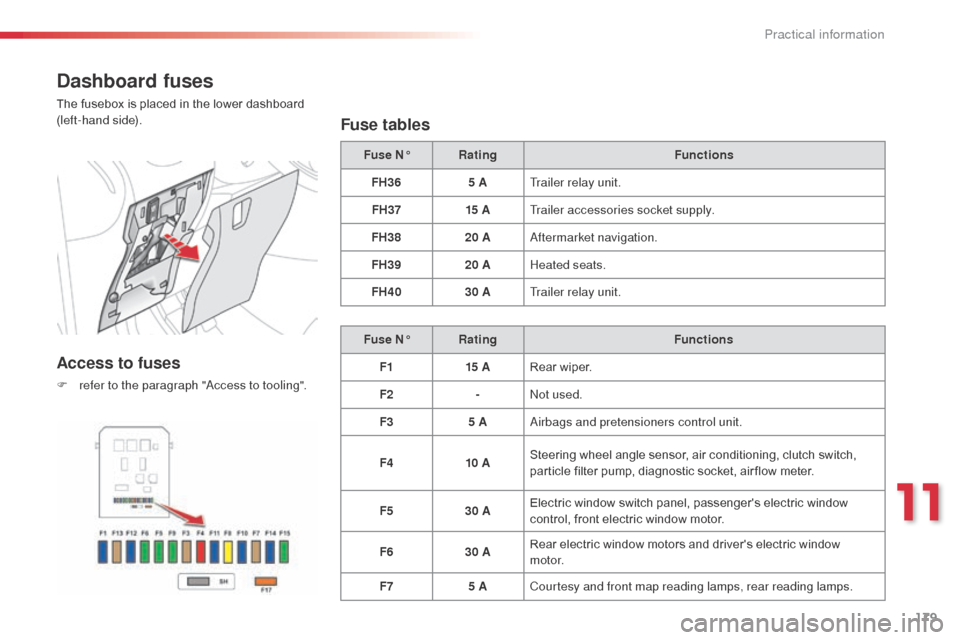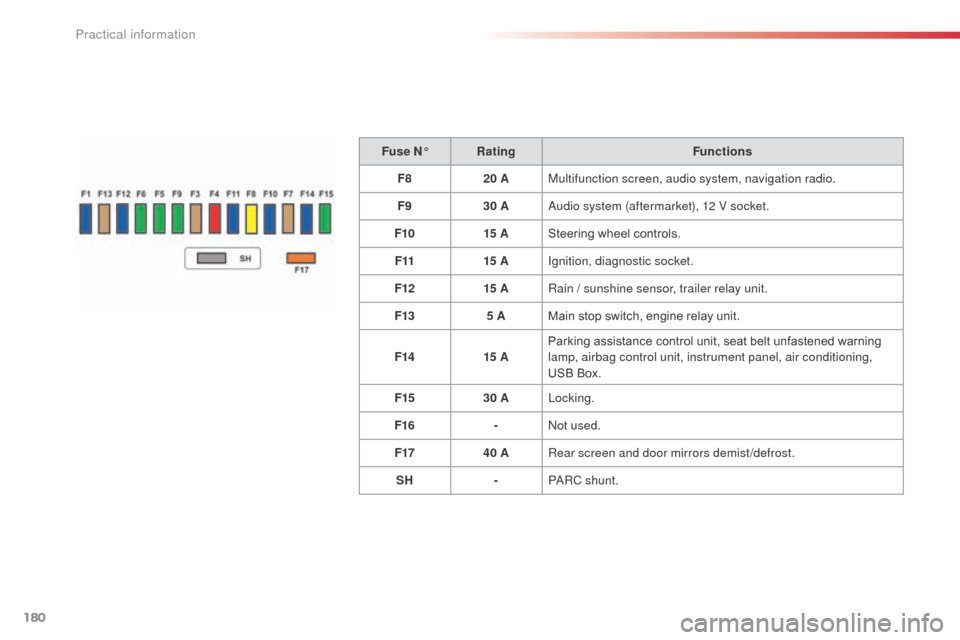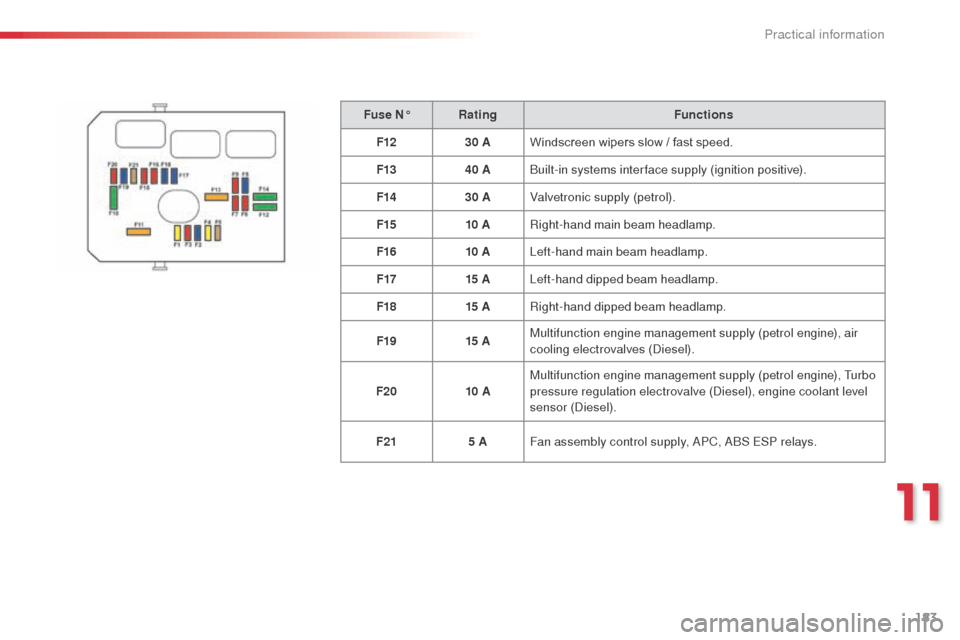Citroen C3 PICASSO 2016 1.G Owner's Manual
Manufacturer: CITROEN, Model Year: 2016, Model line: C3 PICASSO, Model: Citroen C3 PICASSO 2016 1.GPages: 292, PDF Size: 8.23 MB
Page 181 of 292

179
C3Picasso_en_Chap11_informations-pratiques_ed01-2015
Dashboard fuses
The fusebox is placed in the lower dashboard
(left-hand side).
Access to fuses
F refer to the paragraph "Access to tooling".
Fuse tables
Fuse N°Rating Functions
FH36 5 ATrailer relay unit.
FH37 15 ATrailer accessories socket supply.
FH38 20 AAftermarket navigation.
FH39 20 AHeated seats.
FH40 30 ATrailer relay unit.
Fuse N° Rating Functions
F1 15 ARear wiper.
F2 -Not used.
F3 5 AAirbags and pretensioners control unit.
F4 10 ASteering wheel angle sensor, air conditioning, clutch switch,
particle filter pump, diagnostic socket, air flow meter.
F5 30 AElectric window switch panel, passenger's electric window
control, front electric window motor.
F6 30 ARear electric window motors and driver's electric window
motor.
F7 5 ACourtesy and front map reading lamps, rear reading lamps.
11
Practical information
Page 182 of 292

180
C3Picasso_en_Chap11_informations-pratiques_ed01-2015
Fuse N°Rating Functions
F8 20 AMultifunction screen, audio system, navigation radio.
F9 30 AAudio system (aftermarket), 12 V socket.
F10 15 ASteering wheel controls.
F11 15 AIgnition, diagnostic socket.
F12 15 ARain / sunshine sensor, trailer relay unit.
F13 5 AMain stop switch, engine relay unit.
F14 15 AParking assistance control unit, seat belt unfastened warning
lamp, airbag control unit, instrument panel, air conditioning,
USB Box.
F15 30 ALocking.
F16 -Not used.
F17 40 ARear screen and door mirrors demist/defrost.
SH -PARC shunt.
Practical information
Page 183 of 292

181
C3Picasso_en_Chap11_informations-pratiques_ed01-2015
Engine compartment fuses
The fusebox is placed in the engine
compartment near the battery (left-hand side).
Access to fuses
F Unclip the cover.
F C hange the fuse (see corresponding
paragraph).
F
W
hen you have finished, close the cover
carefully to ensure the correct sealing of
the fusebox.
All work on these fuses, located on
the battery, must be carried out by
a CITROËN dealer or a qualified
workshop.
11
Practical information
Page 184 of 292

182
C3Picasso_en_Chap11_informations-pratiques_ed01-2015
Fuse table
Fuse N°Rating Functions
F1 20 AEngine control unit supply, cooling fan unit control, multifunction
engine control main relay.
F2 15 AHorn.
F3 10 AFront / rear wash-wipe.
F4 20 ADaytime running lamps.
F5 15 ADiesel heater (Diesel engine), fuel pump (petrol engine)
F6 10 AABS/ESP control unit, ABS/ESP cut-off relay, secondary stop
switch.
F7 10 AElectric power steering.
F8 25 AStarter motor control.
F9 10 ASwitching and protection unit (Diesel).
F10 30 ADiesel engine injection pump valve, injectors and ignition coils
(petrol engine)
F11 40 AAir conditioning fan.
Practical information
Page 185 of 292

183
C3Picasso_en_Chap11_informations-pratiques_ed01-2015
Fuse N°Rating Functions
F12 30 AWindscreen wipers slow / fast speed.
F13 40 ABuilt-in systems inter face supply (ignition positive).
F14 30 AValvetronic supply (petrol).
F15 10 ARight-hand main beam headlamp.
F16 10 ALeft-hand main beam headlamp.
F17 15 ALeft-hand dipped beam headlamp.
F18 15 ARight-hand dipped beam headlamp.
F19 15 AMultifunction engine management supply (petrol engine), air
cooling electrovalves (Diesel).
F20 10 AMultifunction engine management supply (petrol engine), Turbo
pressure regulation electrovalve (Diesel), engine coolant level
sensor (Diesel).
F21 5 AFan assembly control supply, APC, ABS ESP relays.
11
Practical information
Page 186 of 292

184
C3Picasso_en_Chap11_informations-pratiques_ed01-2015
Table of maxi-fuses
Fuse N°Rating Functions
MF1* 60 ACooling fan assembly.
MF2* 30 AABS / ESP control unit.
MF3* 30 AABS / ESP control unit.
MF4* 60 ABuilt-in Systems Inter face (BSI) supply.
MF5* 60 ABuilt-in Systems Inter face (BSI) supply.
MF6* -Not used.
MF7* -Passenger compartment fusebox.
MF8* -Not used.
*
T
he maxi-fuses provide additional protection for the electrical systems. All work on the maxi-fuses
must be carried out by a CITROËN dealer or a qualified workshop.
Practical information
Page 187 of 292

185
C3Picasso_en_Chap11_informations-pratiques_ed01-2015
BatteryProcedure for charging your battery when it is flat or for starting the engine using another battery.
Access to the battery
The battery is located under the bonnet.
To gain access to it:
F
o
pen the bonnet using the interior release
lever, then the exterior safety catch,
F
s
ecure the bonnet stay,
F
l
ift the plastic cover on the (+) terminal. First check that the slave battery has a
nominal voltage of 12 V and a capacity
at least equal to that of the discharged
battery.
Do not try to start the engine by
connecting a battery charger.
Do not disconnect the (+) terminal when
the engine is running.
F
C
onnect the red cable to the positive
terminal (+) of the flat battery A , then to the
positive terminal (+) of the slave battery B.
F
C
onnect one end of the green or black
cable to the negative terminal (-) of the
slave battery B (or earth point on the other
vehicle).
F
C
onnect the other end of the green or
black cable to the negative terminal C (or
the engine mounting) of the broken-down
vehicle.
F
S
tart the engine of the other vehicle and
allow it to run for a few minutes.
Starting using another
battery
When the battery on your vehicle is discharged,
the engine can be started using a slave battery
(external or on another vehicle) and jump leads.
F
O
perate the starter of the broken-down
vehicle and let the engine run.
I
f the engine does not start immediately,
switch off the ignition and wait a few
moments before trying again.
F
W
ait until the engine returns to idle, then
disconnect the jump leads in reverse order.
Some functions are not available if the
battery is not sufficiently charged.
11
Practical information
Page 188 of 292

186
C3Picasso_en_Chap11_informations-pratiques_ed01-2015
Charging the battery using
a battery charger
F Follow the instructions for use provided by the manufacturer of the charger. Protect your eyes and face before
handling the battery.
All operations on the battery must be
carried out in a well ventilated area
away from naked flames and sources
of sparks, so as to avoid the risk of
explosion and fire.
Do not try to charge a frozen battery;
the battery must first be thawed out to
avoid the risk of explosion. If the battery
has been frozen, before charging have
it checked by a CITROËN dealer or a
qualified workshop who will check that
the internal components have not been
damaged and the casing is not cracked,
which could cause a leak of toxic and
corrosive acid.
Do not reverse the polarity and use only
a 12 V charger.
Do not disconnect the terminals while
the engine is running.
Do not charge the batteries without
disconnecting the terminals first.
Wash your hands after wards.
Batteries contain harmful substances such
as sulphuric acid and lead. They must be
disposed of in accordance with regulations
and must not, in any circumstances, be
discarded with household waste.
Take used remote control batteries and
vehicle batteries to a special collection
point.
Practical information
Page 189 of 292

187
C3Picasso_en_Chap11_informations-pratiques_ed01-2015
Load reduction mode
System which manages the use of certain
functions according to the level of charge
remaining in the battery.
When the vehicle is being driven, the load
reduction function temporarily deactivates
certain functions, such as the air conditioning,
the heated rear screen...
The deactivated functions are reactivated
automatically as soon as conditions permit.
Energy economy mode
Exiting economy mode
These functions are reactivated automatically
the next time the vehicle is driven.
F
I
n order to resume the use of these
functions immediately, start the engine and
let it run for a few minutes.
The time available to you will then be double
the period for which the engine is left running.
However, this period will always be between
five and thirty minutes.
Switching to economy mode
Once this period has elapsed, a message
appears on the multifunction screen indicating
that the vehicle has switched to economy mode
and the active functions are put on standby.
A flat battery prevents the engine from
starting (refer to the corresponding
paragraph).
If the telephone is being used at the
same time on the eMyWay audio
navigation system, it will be interrupted
after 10 minutes.
System which manages the period of use of certain functions to conserve a sufficient level of
charge in the battery.
After the engine has stopped, you can still use functions such as the audio equipment,
windscreen
wipers, dipped beam headlamps, courtesy lamps, etc. for a maximum combined period of
thirty
minutes.
This period may be greatly reduced if the battery is not fully charged.
11
Practical information
Page 190 of 292

188
C3Picasso_en_Chap11_informations-pratiques_ed01-2015
Changing a front or rear wiper blade
Removal
F Raise the corresponding wiper arm.
F U nclip the wiper blade and remove it.
Fitting
F At the front, check the size of the wiper blade as the shorter blade is fitted to the
passenger side of the vehicle.
F
P
ut the corresponding new wiper blade in
place and clip it.
F
F
old down the wiper arm carefully.
Before removing a front
wiper blade
F Within one minute after switching off the ignition, operate the wiper stalk to position
the wiper blades in the vertical position.
This position must be used in order to avoid
damaging the wiper blade and the bonnet.
After fitting a front wiper
blade
F Switch on the ignition.
F O perate the wiper stalk again to park the
wiper blades.
Procedure for replacing a worn wiper blade with a new one without the use of tools.
Practical information